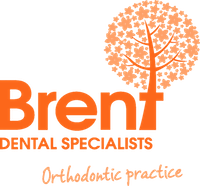Retainers hold newly straightened teeth in place while the surrounding gum and bone adjusts to the new position of the teeth. The tissues around the roots take time to adjust to the new tooth positions and there is a particular risk of relapse in the early months after the brace is removed. Even in the longer term, some risk remains and the best advice is to continue retention indefinitely if at all possible.
Retainers may be removable or fixed, and there are advantages and disadvantages to both.
- Removable retainers are usually worn full time initially but reduced to night times after a period of time. Your orthodontist will tell you how long to use the retainer for. They are effective but obviously depend on the patient remembering to wear them. There are two types called Essix and Hawley and which one you use will be dependent on your treatment type.

- Fixed/bonded retainers are usually bonded to the back surface of the teeth so they cannot be seen during day to day activity. They are therefore in place all the time and are highly effective, though you do have to take care with eating certain food types and performing certain activities. A high standard of tooth cleaning near the retainer wire is essential to avoid gum problems. They do need regular inspection (we recommend a check up every 12 months) because if any of the bonds fail, the tooth in question may start to drift out of position. We guarantee our bonded retainers for 12 months so any repairs made during this period are free of charge. For this reason it is essential for the patient to contact us at once if there is a breakage. Bonded retainers are generally not available as part of NHS care, please see the fee guide for prices for children and for adults.

Frequently Asked Questions
You can find out about this policy at: http://www.nhs.uk/Conditions/Orthodontics/Pages/Howitisperformed.aspx


 Dr Maryam Izadi
Dr Maryam Izadi BDS MFDS RCS Ed MClinDent MOrth RCS Eng FDS (Orth) RCS Eng
BDS MFDS RCS Ed MClinDent MOrth RCS Eng FDS (Orth) RCS Eng Sed ut perspiciatis unde omnis iste natus error sit voluptatem accusantium doloremque laudantium, totam rem aperiam, eaque ipsa quae ab illo inventore veritatis et quasi architecto beatae vitae dicta sunt explicabo. Nemo enim ipsam voluptatem quia voluptas sit aspernatur aut odit aut fugit, sed quia consequuntur magni dolores eos qui ratione voluptatem sequi nesciunt. Neque porro quisquam est, qui dolorem ipsum quia dolor sit amet, consectetur, adipisci velit, sed quia non numquam eius modi tempora incidunt ut labore et dolore magnam aliquam quaerat voluptatem. Ut enim ad minima veniam, quis nostrum exercitationem ullam corporis suscipit laboriosam, nisi ut aliquid ex ea commodi consequatur? Quis autem vel eum iure reprehenderit qui in ea voluptate velit esse quam nihil molestiae consequatur, vel illum qui dolorem eum fugiat quo voluptas nulla pariatur?”
Sed ut perspiciatis unde omnis iste natus error sit voluptatem accusantium doloremque laudantium, totam rem aperiam, eaque ipsa quae ab illo inventore veritatis et quasi architecto beatae vitae dicta sunt explicabo. Nemo enim ipsam voluptatem quia voluptas sit aspernatur aut odit aut fugit, sed quia consequuntur magni dolores eos qui ratione voluptatem sequi nesciunt. Neque porro quisquam est, qui dolorem ipsum quia dolor sit amet, consectetur, adipisci velit, sed quia non numquam eius modi tempora incidunt ut labore et dolore magnam aliquam quaerat voluptatem. Ut enim ad minima veniam, quis nostrum exercitationem ullam corporis suscipit laboriosam, nisi ut aliquid ex ea commodi consequatur? Quis autem vel eum iure reprehenderit qui in ea voluptate velit esse quam nihil molestiae consequatur, vel illum qui dolorem eum fugiat quo voluptas nulla pariatur?” BDS MJDF RCS Eng MClinDent MOrth RCS Eng
BDS MJDF RCS Eng MClinDent MOrth RCS Eng